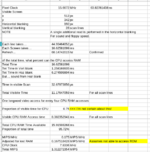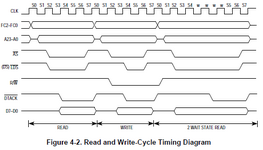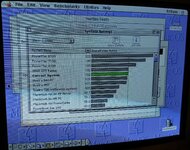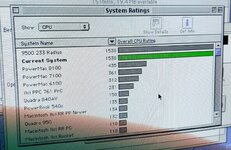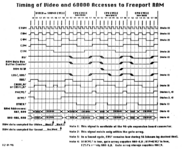NuMac Model Information Update!
My fictitious sources have given me an update on some M88K NuMac product details.
First, the CPU. Apple would probably have influence on the part development. Importantly, for the low-end models I'd specify a cut-down 25MHz CPU with 4kB each of Instruction and Data cache: the 88100
EC25 (about
540K transistors, 25MHz, 2.25W).
Secondly, the models I'd drop the 'better' from the good, better, best principle, leaving only the NuMac41 (an LC-sized NuMac with the cut-down CPU for Math/Science students) and the NuMac 61 (a Q700, 3-NuBus slot with the 33MHz, 3 Chip, chipset for developers and ultra-high end graphics). The NuMac41 would be priced similarly to an LC III, but due to the small cache really, only perform like an 8MHz SE under emulation.
Thirdly: 32-bit QuickDraw performance. Estimating this is a bit tricky. I have a reference to a
MacTech article, which explains that 32-bit QD was rewritten in 'C' for PowerPC and was
much faster, but the images are missing from the archive. So, then I had a look at some MacBench and Speedometer tests:

But this isn't very helpful. I estimated that an M88100 at 25MHz would run at 0.28 x the speed of PPC 601/60MHz, but this means graphics would run at 0.43 on the Speedometer scale - much slower than a Q700. So, I think the tests are misleading here, because they're probably still driven by a lot of 68K code. I think it's better to recalculate based on SpecInt92. The MC68040/25 had a SpecInt92 of 13.5; whereas the M88K at 25MHz had a SpecInt92 of 17.4. So, in theory, then its Graphics performance would be: 0.97.
However, since PowerPC 32-bit QuickDraw was written in 'C', probably the M88100, 32-bit QD would be too - but I'll assume 80% C and 20% Assembler on the 80:20 rule. If I assume compiled 'C' is about 3x slower than assembler, but 80% of the time is in the assembler code, this gives us an effective performance of : 0.333x 0.2 + 0.8 = 0.87 x the ideal speed making it: 0.84.
OK, furthermore I don't think the 4kB caches would make that much worse, because most graphics operations hammer the cache anyway, and most of the inner core code would fit in the 4kB instruction cache, so I'll keep it at 0.84.
That's encouraging, because for tuned M88100 applications, a NuMac R41 would give graphics performance better than a Q700, for the price of an LCIII (whose graphics performance is 0.32). For the NuMac61, the performance would be 1.1 and only a Q650 beat that.
Fourthly: One of the main issues with the early PowerPC development was the compilers, with Metrowerks saving the day. Maybe MW could have produced a decent M88K compiler by 1992, but I think it's better to assume most students and initially even most developers wouldn't have access to that. They'd either still be running THINK C (or THINK Pascal) or MPW C or Pascal. Only Apple would have access to Motorola's M88K compilers.
So, I think the easiest solution there is for Apple to provide pre-built libraries for M88K accelerated functionality: 3D graphics, matrix math, statistics, graphics filters etc. I think it's fairly safe to assume that maths performance for the M88K is more like PPC 601 math (it didn't have a MAC, but it had two Execution Units, one for Multiplies and the other for addition, so it could have competed). We can expect 44 for Math.
Function headers and Units would come with the library code, and developers would literally just add
CdeR resources to applications. The NuMac Mixed Mode Manager would pull in
CdeR resources when emulated code attempts to access M88K functions in the jump table.
And this concludes the latest fantasy M88K ramblings!
